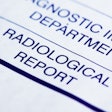
Paid family medical leave has benefits for radiology practices and should be normalized. This could help reduce the loss of female medical students from the pipeline of those picking radiology as a specialty, according to an editorial published March 22 in Clinical Imaging.
In their editorial, Dr. Elizabeth Arleo from New York-Presbyterian Hospital and Dr. Kristin Porter, PhD, from the University of Alabama at Birmingham wrote about how radiologists and practices can benefit from paid family medical leave and how costs can be mitigated.
"Paid family medical leave supports those who experience a serious medical condition themselves [or have family members who do] and those who experience pregnancy and childbirth or adoption," the two wrote. "These conditions apply to essentially all radiologists at some point in their career."
Family medical leave has been a discussion over the past couple of years for the American College of Radiology (ACR). A paid leave resolution was deferred in 2020 due to the COVID-19 pandemic.
In 2021, ACR councilors passed the American Association for Women in Radiology (AAWR) amendment to resolution 48. This supported 12 weeks of family medical leave for diagnostic radiology, interventional radiology, radiation oncology, and nuclear medicine residents.
However, Arleo and Porter wrote that the resolution did not specify whether the leave was paid or unpaid.
The Family and Medical Leave Act (FMLA) of 1993 provides eligible employees with up to 12 weeks of job-protected leave per year for the care of a newborn or adopted child. However, this does not mandate paid leave.
The Federal Employee Paid Leave Act (FEPLA) of 2019, meanwhile, allows federal workers up to 12 weeks of paid time off for the birth, adoption, or placement of a new child. However, this does not include paid leave for medical reasons.
"Radiology has a 'leaky pipeline' in which women drop out in early career levels, leading to their underrepresentation at advanced ranks and in leadership positions," Porter told AuntMinnie.com. "This leaky pipeline compromises inclusion by diluting women's voices and decision-making authority."
Arleo and Porter wrote in the editorial that societal benefits for paid family medical leave for radiologists include more timely immunizations and pediatric visits and job satisfaction and less infant mortality, infant and mother hospitalizations, and postpartum depression among others. They also noted that more job productivity, loyalty, and morale are seen.
The two also wrote about costs for practices, which they said can be mitigated with short-term disability, state programs, and careful organizational planning. An example they use is practices and departments being able to cover leave by bringing radiologists onsite or providing coverage with remote work.
Other benefits they included are decreased hiring costs through employee retainment and decreased presenteeism. They wrote that these outweigh the costs of continued pay and benefits, as well as administrative costs.
Porter added that while there may not be much advance notice in cases of serious medical conditions personally or in immediate family members, there is "generally" a natural, built-in lead time of several months for a new baby during which coverage can be organized.
"Practices must also keep front of mind benefits to such a policy, including reduced hiring costs by retaining employees and increased productivity of employees who take sufficient leave and return ready to work," said Porter, who is a member and past president of the AAWR.




















